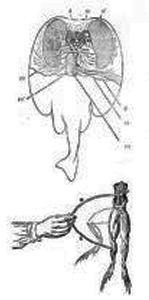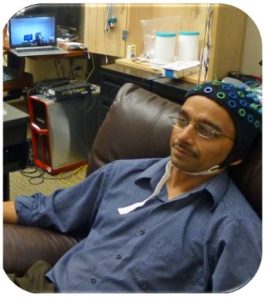3 Brain and Spinal Cord Stimulation
Welcome to Day 3 of the YSP-REACH Program! Yesterday you explored brain-computer interfaces. Today you will hear from CNT co-Director, Dr. Chet Moritz, about a different neurotechnology known as neurostimulation. The resources below include a brief history of electrical stimulation of the nervous system, an overview of the main types of neurostimulation techniques, and a research spotlight focused on the work of Dr. Chet Moritz and his team.
Part One: History of Electrical Stimulation of the Nervous System
A bit of history about electrical stimulation of the nervous system:
- In the mid-1700s, Luigi Galvani demonstrated that electricity could make a frog leg twitch. Alessandro Volta showed that biological electricity is similar to other types of electricity; he also invented the battery.
- In the mid-1900s, neurosurgeons applied electricity directly to the surface of the brain to cause sensation and movement.
Part Two: Neurostimulation Techniques
With neurostimulation, there are several ways that the nervous system is stimulated:
- Microelectrodes: activate a population of neurons (axons) close to the electrode. The number of neurons depends on stimulation parameters and large neurons and those neurons near the electrode are activated by lower currents. Microelectrodes are used for deep brain stimulation, cochlear implants, cortical surface, and spinal cord stimulation. Electrocorticography (ECoG ) electrodes are placed on the surface of the brain and may activate several thousands of neurons.

- Optical stimulation (Optogenetics): requires both light and genetic manipulation to control neurons.
- Transcranial magnetic stimulation: a magnetic field passes through skin and skull, inducing an electric current in the brain. The maximum depth that magnetic stimulation reaches is 3-5 cm.
- Transcranial ultrasound: sound waves travel through bone and soft tissues. Low-intensity pulsed ultrasound influences neural activity without heating the tissue.
Part Three: CNT Research Spotlight
Today, Dr. Chet Moritz will share how he and his team at the University of Washington are using neurostimulation to help rehabilitate spinal cord injuries. In this section, you will watch a news video and read two articles. Then contribute to today’s Padlet.
Watch a UW Medicine video about Dr. Chet Moritz, his research and research participant Jessie Owen:
Photos from the Moritz Lab
Watch & Read This!
Learn about the spinal cord rehabilitation work in the Moritz lab by exploring these resources. These resources tell the stories of Joe Beatty and Jessie Owen, who were paralyzed due to spinal cord injuries experienced during accidents (body-surfing accident and car accident).
- KING 5 News video. In this short video, you will see how the Moritz lab has helped Joe regain important bodily functions.
- KUOW News article about Jessie Owen and Chet Moritz. Jessie also maintains an Instagram page. You can also watch a short video about the impacts of the CNT clinical trial on her on the CNT YouTube page.
- Read how transcutaneous spinal cord stimulation research based on CNT work has gained FDA approval.
Try It!
After watching the news video and reading the article, respond to this question on a Padlet:
- What questions do you have for Dr. Moritz and his team?
Post your questions to this Questions about Spinal Cord Stimulation Padlet. See what other REACH participants have posted as well. You can “favorite” the ones you agree with or add comments.
Then, hit the “back” arrow on your web browser to return to this chapter and keep reading.
Tomorrow we will hear about brain-computer interfaces (BCIs) or brain-machine interfaces (BMIs) from Dr. Amy Orsborn.
Citation: Photo credits: Center for Neurotechnology.
Very small electrodes used for either recording neural signals or for electrical stimulation (i.e., electrical stimulation of the brain or spinal cord).
A technique for recording the electrical activity of the brain obtained from electrodes placed on the surface of the brain. ECoG is an invasive way to record signals from the brain, requiring surgery to access the brain’s surface.
A technique used by neuroscientists that uses both light and genetic manipulation to control neurons. Neurons are genetically manipulated to be light-sensitive, thus enabling light to cause neurons to fire.
A non-invasive method of stimulating neurons in the brain in which a magnetic field passes through the skin of the scalp and the skull, inducing an electric current in the brain. The maximum depth that magnetic stimulation reaches is 3-5 cm.
A non-invasive technique in which sound waves travel through bone and soft tissues to the brain. Low-intensity pulsed ultrasound influences neural activity without heating or damaging the tissue.
A communication pathway linking neural signals from the brain with an external device. The neural signals are decoded by a computer using an algorithm that translates the signals into a motor output (action), such as controlling a neuroprosthetic hand or steering a wheelchair. BCIs may operate using either EEG or ECoG recordings or single unit activity from neurons. Also called a Brain-Machine Interface or a Brain-Control Interface.

